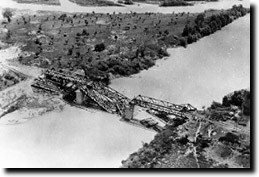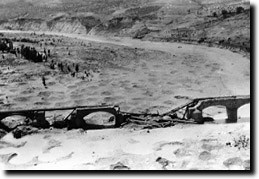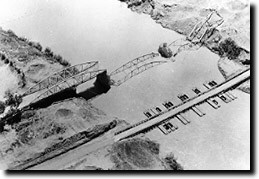|
|
| |
 |
| |
Another
span downed as part of Operation
Strangle |
A
tasking to which the B-26 Groups were assigned was that
of “Operation Strangle”. In an effort to hamper logistic
supply of the German Army fighting the Allies in the
middle of the Italian peninsula, the B-26’s
were assigned to destroy any means of lines of
supplies to the enemy. This meant knocking out as many
key bridges as possible, disrupting the rail service,
bombing the German Main Supply Routes (MSRs) plus their
harbors, and then go back and do it all over again.
As you can see by the picture, these bombs seemed to
have done the trick on
the bridge as shown.
| |
 |
| |
|
Many
times the bombs we dropped were time delayed as to detonation
and these explosion times were staggered. The repair
crews didn’t know if or when a delayed bomb would ruin
their coffee break or even their whole lunch hour. The
German supply lines were already stretched quite long
and this constant hammering of critical, key bridges,
rail lines, and marshaling yards must have played
havoc on their capability to feed and supply their own
troops.
At first, I used to wonder why we would be given
a mission to hit a certain bridge which I knew we had
successfully hit before, only to go back and to it again. Later
on in the fighter tour I also went, time after time,
targeted for an objective which I knew very well we
earlier successfully bombed. The reason of course
is that the Germans became experts at bomb damage repair.
This game of ‘musical chairs’ was all a part of the
Strangle Strategy. The harassment that over all must
have been a significant deterrent to their war efforts.
| |
 |
| |
|
I’m
getting a little bit ahead of myself, but it ties in
with this theme. Later on, while I was assigned to the
86th Fighter Group, fighter sweeps looking for ground
transport were the name of the game. Unfortunately,
at least for Ox cars, one of our P-47’s hit an Ox car;
a two-wheeled cart drawn by one ox and the cart blew
sky high. This was the clue that they were so desperate
for transportation that they had resorted to moving
munitions by this archaic means. It also meant that
Oxen longevity had hit a new low. I understand that
the above Operation Strangle and this use of air power
did in fact play a part in the 5th Army finally being
able to take Rome. These pictures of B-26 bombing
results gives you but a small sample of why “Strangle”
must have helped the war effort.
|
![]()




















 Epochal Missions of the 320th B.G.
Epochal Missions of the 320th B.G. Operation Strangle
Operation Strangle


